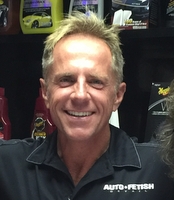Clear Coat Restoration
Questions you didn't know to ask
Any Internet search on clear coat restoration will deliver a mind-blowing amount of information. The real problem is that you won't have enough experience to even begin asking the right questions.
I used to call the Internet "Information Overload". Now I call it "Misinformation Overload".
But the fact that you still ask means there is hope.
Darren's Note: Clear coat restoration can mean many things to many people. What I will be discussing here is the ability to restore the clear coat on your car IF it can actually be restored, versus clear coat on a car that is so damaged that the only solution would be repaint.
This page will not discuss any repainting options or techniques to restore your clear coat.
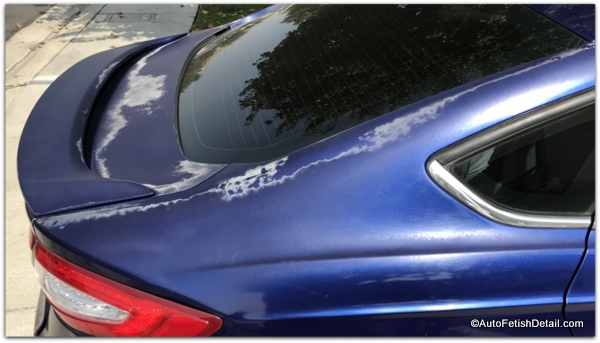 The clear coat damage seen on this car cannot be restored through polishing of any kind. This clear coat has completely failed and this car needs to be repainted.
The clear coat damage seen on this car cannot be restored through polishing of any kind. This clear coat has completely failed and this car needs to be repainted.Clear Coat Restoration:
Asking the right questions
What are the right questions?
Well if you knew that, then you would already be asking. But you don't, so I will be asking for you.
And along the way you will become an informed car owner and an informed consumer.
- What is clear coat?
- What is clear coat restoration?
- What is the best way to restore clear coat?
What Is Clear Coat
Before you attempt to restore clear coat it is a good idea that you have sufficient understanding of what clear coat is, and what it isn't.
At the most basic level, clear coat is paint on your car that has no pigment/color to it. And the reason this is important is that clear coat restoration is essentially the same as car paint restoration.
But that is an over-simplified answer.
Without overloading you technical data, the major difference between clear coat and traditional car paint is that clear coat oxidizes much differently than old school paint jobs.
Clear coats don't become dull and chalky like the paint jobs of 30+ years ago used to. Clear coats basically dry out, then can begin to peel, flake, and blister. Often the worst cases of clear coat failure are a result of adhesion problems or inferior clear coats used by the car manufacturer's.
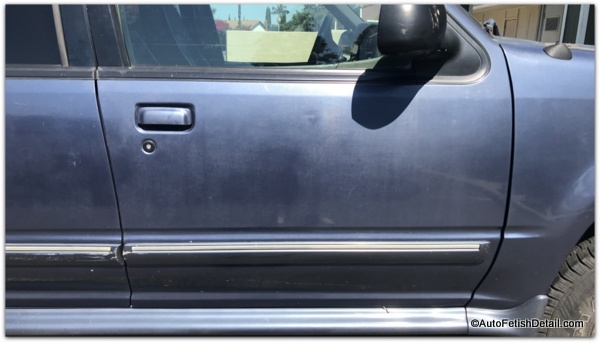 The side of this Ford Explorer is a perfect example of how clear coat dries out over time and is in desperate need of some clear coat restoration
The side of this Ford Explorer is a perfect example of how clear coat dries out over time and is in desperate need of some clear coat restorationWhat all this ultimately means is that clear coat restoration is a case by case situation. Just know that in most cases you are experiencing a lack of shine, luster, and depth to your clear coat and therefore came looking for ways to perform some type of clear coat restoration.
Before you get too discouraged!
Know that in most cases you can restore your clear coat to a new level of depth, shine, and gloss if you follow along with me.
How Do You Know If Your Car Has Clear Coat
Your car has clear coat. Yes, it really does.
Most specifically, your car was finished with a clear coat as the top layer of the overall paint system used to finish your car at the factory. Clear coat is part of the overall paint finishing process used by every car manufacturer.
Each car manufacturer will ultimately source their paint, clear coat, and other "parts" of the overall paint system from different vendors. The basic steps and layers of factory paint systems remain the same regardless of the car manufacturer:
- Body panel
- Corrosion resistant layer (this applies to metal body panels - most modern day cars are made with both metal and composite type materials)
- Primer layer
- Color layer
- Clear coat layer
Why Are Cars Painted With Clear Coat
Due to increasing air quality regulations, car manufacturer's were driven to find ways to meet the higher standards imposed my government regulations. The base coat (color coat) and clear coat system was develop in direct response to meeting tighter VOC regulations. (VOC stands for volatile organic compounds)
At a very basic level clear coat is simply "paint" with no color to it. This clear layer applied over the color coat serves 3 basic purposes:
- The clear coat paint system (also referred to as a 2-stage paint) allows car manufacturers to comply to tighter VOC regulations
- The clear coat is what creates the gloss and shine to the color coat
- Clear coat filters out/absorbs damaging UV rays from the sun to protect the color coat
If you are old enough to remember the days before the introduction of clear coat paint systems (2-stage paint), you will recall how the paint on cars would become dull and chalky. Red paint jobs were notorious for turning into a chalky "pink" type of color as the red paint oxidized.
Clear coat does not oxidize in this same manner. As a rule, clear coat will simply dry out over time. This drying out process has the ability to take on different appearances based on how neglected the clear coat has been.
Clear Coat Restoration Process
Clear coat restoration can be divided into two areas:
- Temporary (paint enhancement)
- Permanent (paint correction)
Paint enhancement is as simple and basic as adding a fresh coat of wax to your car. Most people understand that car wax will instantly increase the overall look and appearance to their car's paint, but is also a temporary fix.
Paint correction is the process of using abrasive technology (in the form of compounds and/or polishes) to abrade away unwanted dried out clear coat, dead paint, imperfections, or paint scratches.
This can be done by hand or machine. I personally only recommend attempting clear coat restoration by machine, as attempting to do this by hand is an exercise in futility in my opinion.
And since the industry has developed machine polishers that are amazingly safe, now a true beginner like yourself can achieve professional level results without fear of damage.
Clear Coat Restoration:
What Would Darren Do (WWDD)
In so many instances I am asked by people just to tell them what I would do. Which is why I label this as What Would Darren Do.
I follow these steps:
- Wash car (you need to start with a "clean" surface)
- Decontaminate car paint using clay bar (this is what you can call a deep clean of your car paint-which is really not paint but clear coat)
- Use a dual action buffer and car polish to polish your car
- Finish by applying a coat of car wax
This bullet list might seem like a extreme simplification, but those are the exact steps you will need to go through to having the best chance of restoring the clear coat on your car.
I will cover each step based on what I think you need to know for that step.
1) Wash Car
I realize this might be an obvious to you as a person, but what you consider obvious, is not so obvious to the next person who might have even less knowledge and experience than yourself.
We all come to the subject of clear coat restoration with different experience levels and different knowledge. I will not attempt to teach you how to wash your car here since you can go to my dedicated page on car washing.
2) Car Paint Decontamination
Your paint should feel smooth (after you have washed it) when sliding your hand or fingers across it. In most cases if you perform this test on your car you will feel like there are very tiny particles stuck to your car paint (clear coat).
This is normal since these tiny particles are nothing more than many types of dirt particles in tbhe form of air pollution that begin to bond to the clear coat of your car.
Traditional washing and even waxing your car will not remove these bonded surface contaminants (That's more of an official description of this air pollution)
This might be a totally new concept to you, but what most people like yourself do not know is that all that talk about air pollution is not just about your physical health, but the health of your car paint.
"Air pollution refers to any physical, chemical or biological change in the air. It is the contamination of air by harmful gases, dust, and smoke which affects the plants, animals, and humans drastically" as per byjus.com
Since most people talk of air pollution with regards to humans and nature, very little is discussed with how air pollutants can also be damaging to materials like the clear coat on your car.
The simple understanding you need before you attempt clear coat restoration is to know that some of the pollutants within air pollution have the ability to attach and become bonded to the clear coat.
Firstly, these bonded contaminants are not good for your clear coat in general. Secondly, these bonded contaminants create a gritty feel to your paint (most people want their paint to feel silky smooth). Thirdly, this grit will also cause unwanted friction and interference when polishing the clear coat. This added friction due to the paint not being smooth before polishing will make any clear coat restoration process more frustrating and difficult overall.
Therefore I highly recommend this initial step of decontaminating your clear coat with what is most often called detailing clay or simply, the "clay bar".
3) Polishing Car
If you have followed the steps to clear coat restoration thus far, you are now ready to polish the clear coat on your car.
You will have washed it to remove what I call superficial dirt, and you will have "deep cleaned" the clear coat using the clay bar to remove the bonded paint contaminants that will have stuck to your clear coat.
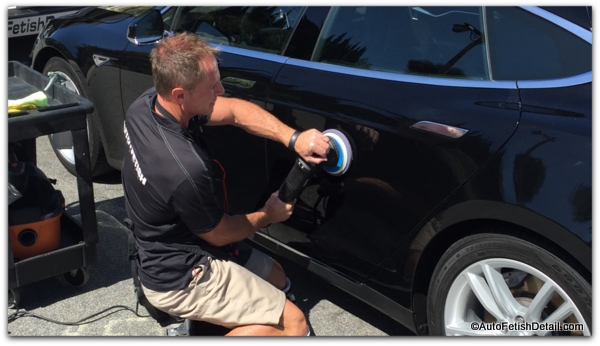
At this point your car paint will feel silky smooth and now be ideal for the next stage of clear coat restoration.
Polishing your car with a car polish that has actual abrasives is the only true way to restore the clear coat in a more permanent manner. The abrasive particles formulated into car polishes will allow you to "scratch" your way to success by creating depth, gloss, and shine.
Car Polishing Made Simple
Polishing the paint on your car to restore the shine, depth and gloss on your clear coat will involve numerous products and "tools" to achieve desired results.
- Machine buffer (dual-action, random orbital)
- Car polishes (compound and polish)
- Buffing pads (different pads based on desired "cut")
You can shop the necessary items individually, or you can keep your life simple by shopping a car polishing kit like the one from Adam's below.
Adam's Car Polishing Kit
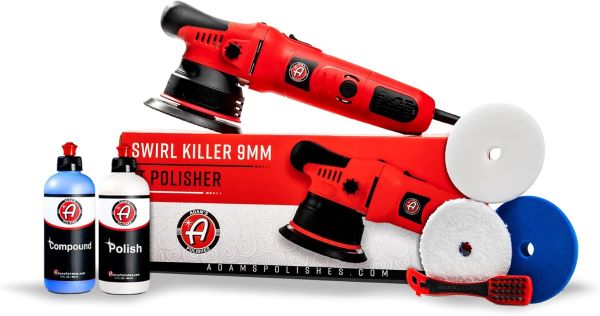
Adam's Car Polishing Kit on Amazon
- Safest possible way to machine polish a car
- The only polisher I recommend for a complete beginner
- So safe, you would have to deliberately try and do damage to your car
Darren's Note: Any horror stories of polishing your car with a machine polisher are tied to the high-speed rotary car polishers. The industry has responded to the need of beginners to safely polish their car without the dangers associated with using a high-speed polisher.
These random orbital car polishers are as safe as safe can get!
Any beginner can use one safely and effectively to produce professional results right out of the box.
Speed settings allow even the most fearful of people to dial the buffer down to incredibly low speeds, thus allowing a true beginner to ease into the polishing in a way they are completely comfortable with.
Micro-Fiber Detail Cloths
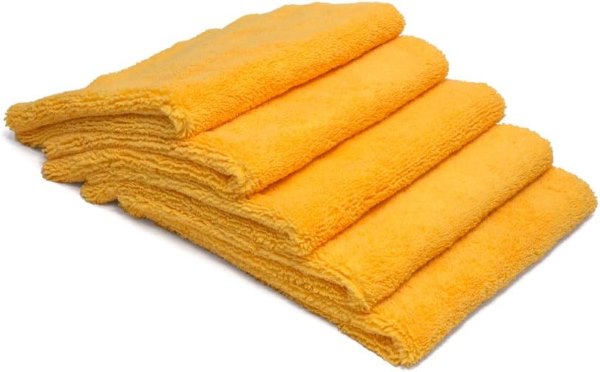
AutoFiber Edgeless Microfiber Cloths on Amazon
- You will need some microfiber cloths to remove the polish as you are working
- Th winning balance between spending enough on quality microfibers without spending too much
Darren's Note: You can obsess over the "best" micro-fiber cloth and you will get overloaded with the endless opinions circulating the topic.
If you have never used a micro-fiber cloth for anything, then this becomes the most important take away. Micro-fiber material is superior to any other cloth material you can use.
Especially when it comes to working on clear coat (car paint), there is no other cloth material I would recommend. You can obsess about the perfect micro-fiber cloth later, but right now you don't have to overthink it.
Clear Coat Restoration:
Tips from Darren
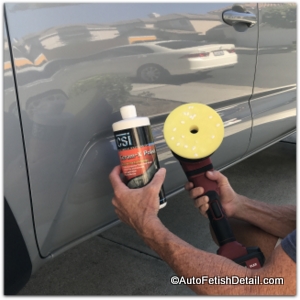
I have laid out the specific products and tools I not only recommend, but use professionally. With that said I want to lay out some additional points to help you achieve the best results as possible on your journey of clear coat restoration.
- It is always best to polish in a shaded area on a cool paint surface
- Your clear coat may be so neglected and dried out that attempting to restore your clear coat may simply be unrealistic
- Apply between 8-12 pea size drops of polish directly to your polishing pad
- The compound is for the heavy lifting or the initial "cutting" to perform the more aggressive work of restoring the paint finish by removing unwanted paint defects. The polish is used to refine the paint finish to your desired level of perfection
- Keep buffer flat against car panel you are polishing and work an area approx. 1' x 1' in size
- Work panel by going side to side and then up and down until area has been completely polished
- Choose whichever pad you are most comfortable with and "ease into" the process based on your comfort level
- Do a single section and then check your results by wiping area with micro-fiber cloth to remove any compound/polish residue
- Repeat using more or less pressure based on the results you are achieving
- As you become more familiar with using the buffer and polish, you can increase or decrease your working area based on your comfort level
Clear Coat Restoration Summary
At this point you are now armed with the exact information I teach to the countless guys who I have taught how to use a machine buffer and perform clear coat restoration on their own cars.
The information and recommendations I make here are not just the techniques I teach, but the exact steps I use professionally as a professional detailer.
I wish you much success!
Sincerely,
Darren Priest
- Home
- Car Clear Coat
- How to Buff Clear Coat
- This Page
|
|
